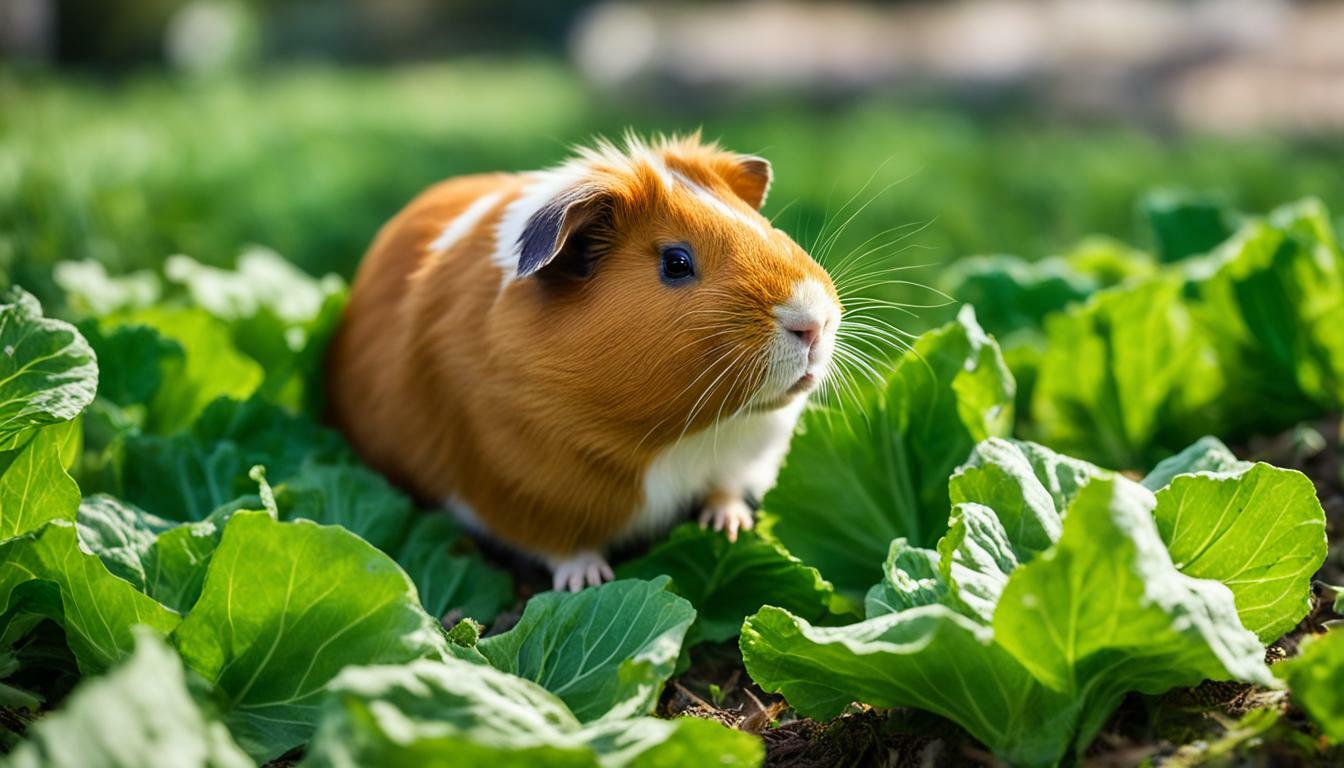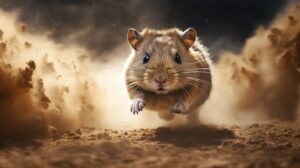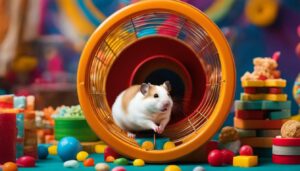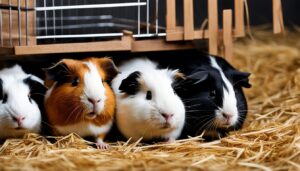If you’re wondering if guinea pigs can eat napa cabbage, you’ve come to the right place to find out.
Napa cabbage is safe for guinea pigs to eat, but it should be fed sparingly due to its high calcium content. Guinea pigs can enjoy napa cabbage two to three times a week. Napa cabbage is a type of Chinese cabbage that is low in calories and contains high levels of vitamin C. However, excessive calcium in their diet can lead to the formation of bladder stones in guinea pigs.
Other health benefits of napa cabbage include being rich in antioxidants, dietary fiber, folate, vitamin K, and other essential vitamins and minerals. Guinea pigs should not eat napa cabbage every day and should be fed it in moderation to avoid health issues such as bladder stones, bloat, and diarrhea. Green cabbage and savoy cabbage are not as suitable for guinea pigs due to their higher calcium content, while red cabbage is a better option as it contains more vitamin C.
It’s important to prepare and serve napa cabbage correctly, washing it thoroughly, removing the core, and cutting it into small pieces before feeding it to your guinea pig. Overall, napa cabbage can be a treat for guinea pigs, but it should not be their main food source.
Key Takeaways:
- Napa cabbage is safe for guinea pigs, but should be fed sparingly due to its high calcium content.
- Guinea pigs can enjoy napa cabbage two to three times a week.
- Excessive calcium in their diet can lead to bladder stones in guinea pigs.
- Napa cabbage is low in calories and high in vitamin C.
- Green cabbage and savoy cabbage are not as suitable for guinea pigs due to higher calcium content.
The Dietary Needs of Guinea Pigs
Before we delve into whether guinea pigs can eat napa cabbage, let’s first understand their dietary needs. Guinea pigs are herbivores, which means their diet should consist mainly of fresh hay, high-quality guinea pig pellets, and a variety of fresh vegetables and fruits. These small pets have specific dietary requirements that must be met to ensure their overall health and well-being.
Nutrition plays a crucial role in guinea pigs’ lives, as it supports their growth, helps maintain a healthy weight, and boosts their immune system. The key nutrients that guinea pigs need include vitamin C, fiber, calcium, and a range of essential vitamins and minerals. Vitamin C is especially important for these furry friends, as they cannot synthesize it on their own and need a daily intake to prevent scurvy.
When it comes to the nutritional value of napa cabbage for guinea pigs, it is essential to consider its calcium content. While napa cabbage is safe for guinea pigs to eat, it should be fed sparingly due to its high calcium content. Excessive calcium in their diet can lead to the formation of bladder stones, which can cause discomfort and urinary issues. As a result, guinea pigs can enjoy napa cabbage two to three times a week, along with other recommended vegetables to maintain a balanced diet.
The Nutritional Benefits of Napa Cabbage for Guinea Pigs
Although napa cabbage should be fed in moderation, it does have some nutritional benefits for guinea pigs. Napa cabbage is a type of Chinese cabbage that is low in calories and high in vitamin C. It also contains other essential vitamins and minerals, such as vitamin K, folate, and dietary fiber. Additionally, napa cabbage is rich in antioxidants, which can help boost guinea pigs’ immune system and protect their cells from damage. However, it’s important to note that napa cabbage should not be their main food source and should only be included as part of a balanced diet.
| Nutrient | Amount per 100g |
|---|---|
| Calories | 13 |
| Vitamin C | 16.4 mg |
| Dietary Fiber | 1.2 g |
| Calcium | 77 mg |
| Vitamin K | 38.2 mcg |
| Folate | 41 mcg |
When introducing napa cabbage to your guinea pig’s diet, start with small amounts and closely monitor their reaction. If any digestive issues occur, such as diarrhea or bloating, discontinue feeding napa cabbage and consult with a veterinarian. It’s important to remember that every guinea pig is different and may have individual dietary preferences and tolerances.
The Safety of Napa Cabbage for Guinea Pigs
Now that we know the dietary needs of guinea pigs, let’s explore the safety of napa cabbage for them. Napa cabbage, also known as Chinese cabbage, is safe for guinea pigs to eat, but it should be fed sparingly due to its high calcium content. While guinea pigs can enjoy napa cabbage as part of their diet, it’s important to understand the potential risks and benefits.
Napa cabbage is a low-calorie vegetable that contains high levels of vitamin C, which is essential for guinea pigs. It also provides antioxidants, dietary fiber, folate, vitamin K, and other essential vitamins and minerals. However, the high calcium content in napa cabbage can be problematic for guinea pigs if consumed excessively. Excessive calcium in their diet can lead to the formation of bladder stones, which can be painful and potentially fatal. Therefore, it’s crucial to feed napa cabbage to guinea pigs in moderation.
To ensure the safety of napa cabbage for guinea pigs, it’s recommended to feed it to them two to three times a week. Additionally, it’s important to include a variety of vegetables in their diet to provide a balanced nutrition. While napa cabbage can be a treat for guinea pigs, it should not be their main food source. Other cabbage varieties, such as green cabbage and savoy cabbage, have a higher calcium content and are not as suitable for guinea pigs. Red cabbage, on the other hand, is a better option as it contains more vitamin C.
| Nutrient | Napa Cabbage (per 100g) |
|---|---|
| Vitamin C | 36.6mg |
| Calcium | 48mg |
| Vitamin K | 45.5mcg |
| Fiber | 1.2g |
When feeding napa cabbage to guinea pigs, it’s essential to prepare and serve it correctly. Start by washing the cabbage thoroughly to remove any dirt or pesticides. Remove the core and any wilted leaves before cutting the cabbage into small, bite-sized pieces. This will make it easier for your guinea pig to chew and digest. Introduce napa cabbage gradually into their diet, and if you notice any signs of digestive issues such as bloat or diarrhea, discontinue feeding it to them.
In conclusion, napa cabbage can be a healthy addition to your guinea pig’s diet, but it should be fed in moderation. It provides beneficial nutrients like vitamin C and dietary fiber, but the high calcium content can pose risks if overconsumed. Remember to include a variety of vegetables in your guinea pig’s diet and consult with a veterinarian for specific dietary recommendations.
Napa Cabbage and Guinea Pigs: A Balanced Approach
While napa cabbage can be a healthy addition to a guinea pig’s diet, it’s important to approach it with balance. This Chinese cabbage variety is low in calories and packed with essential nutrients, making it an attractive option for guinea pig owners. However, due to its high calcium content, napa cabbage should be fed sparingly to avoid potential health issues.
Napa cabbage can be a treat for your furry friend, but it should not be their main food source. Guinea pigs have specific dietary needs that require a variety of fresh vegetables, hay, and pellets to ensure they receive the necessary nutrients. Incorporating napa cabbage into their diet can provide additional vitamins and minerals, but it should be done in moderation.
In comparison to other cabbage varieties, napa cabbage contains lower levels of calcium, making it a safer alternative for guinea pigs. Green cabbage and savoy cabbage have higher calcium content, while red cabbage is a better option due to its higher vitamin C content. It’s essential to consider the nutritional balance of your guinea pig’s diet when introducing napa cabbage or other cabbage varieties.
Recommendations for Including Napa Cabbage in Your Guinea Pig’s Diet
When offering napa cabbage to your guinea pig, it’s important to follow these guidelines:
- Wash the napa cabbage thoroughly before feeding it to your guinea pig to remove any dirt or pesticides.
- Remove the core and any tough outer leaves, as they can be difficult for your guinea pig to digest.
- Cut the napa cabbage into small, manageable pieces to make it easier for your guinea pig to eat.
- Introduce napa cabbage gradually, starting with small amounts and monitoring your guinea pig’s response. If any digestive issues or unusual behavior occur, consult a veterinarian.
Remember, napa cabbage should only be given to guinea pigs two to three times a week to prevent an overabundance of calcium in their diet, which can lead to health issues like bladder stones. Offering a diverse range of vegetables, including leafy greens and other low-calcium options, will help ensure a well-balanced and nutritious diet for your furry companion.
| Benefits of Napa Cabbage for Guinea Pigs | Potential Health Issues and Risks |
|---|---|
|
|
The Importance of Moderation in Feeding Napa Cabbage
Now that we understand the benefits and precautions, let’s discuss why moderation is key when feeding guinea pigs napa cabbage. While napa cabbage is safe for guinea pigs to eat, it should be given in moderation due to its high calcium content. Excessive calcium in their diet can lead to the formation of bladder stones in guinea pigs, which can be painful and potentially dangerous.
Guinea pigs can enjoy napa cabbage two to three times a week as part of a balanced diet. It’s important to remember that napa cabbage should not be their main food source, but rather a treat to add variety to their meals. Including too much napa cabbage in their diet can cause health issues such as bloat, diarrhea, and other gastrointestinal problems.
When considering feeding napa cabbage to your guinea pig, it’s crucial to consider their overall dietary needs. While napa cabbage is low in calories and rich in vitamin C, it should not replace other essential foods they require for proper nutrition. A well-balanced diet for guinea pigs consists of hay, fresh vegetables, pellets, and water. Napa cabbage can be included as a part of their vegetable intake, but it should be served alongside other suitable vegetables to ensure they receive a diverse range of nutrients.
It’s also worth noting that not all cabbage varieties are equally suitable for guinea pigs. While napa cabbage is a good choice due to its lower calcium content, green cabbage and savoy cabbage have higher levels of calcium, making them less ideal for guinea pigs. If you’re looking for an alternative, red cabbage is a better option as it contains more vitamin C.
To prepare napa cabbage for your guinea pig, ensure you wash it thoroughly to remove any dirt or pesticides. Remove the core and any wilted or damaged leaves, and then cut the cabbage into small, bite-sized pieces. This will make it easier for your guinea pig to chew and digest.
In conclusion, napa cabbage can be a healthy addition to a guinea pig’s diet when fed in moderation. However, it’s important to remember that it should not be their main food source and should be served alongside other vegetables and a balanced diet. By following these guidelines and monitoring your guinea pig’s health, you can safely incorporate napa cabbage as part of their dietary variety.
Preparation and Serving Tips for Napa Cabbage
Before offering napa cabbage to your guinea pig, it’s essential to know how to prepare it correctly. Follow these tips to ensure that your furry friend enjoys this leafy green safely:
- Start by thoroughly washing the napa cabbage to remove any dirt or pesticides. This helps to ensure that your guinea pig is not exposed to harmful substances.
- Remove the tough core of the cabbage and discard it. The core can be difficult for your guinea pig to chew and digest, so it’s best to remove it.
- Cut the napa cabbage into small, bite-sized pieces. Guinea pigs have small mouths and can choke on large pieces of food. By cutting the cabbage into smaller, more manageable pieces, you reduce the risk of choking.
- Introduce the napa cabbage gradually into your guinea pig’s diet. Start with small amounts to see how your pet reacts and ensure that there are no adverse effects such as diarrhea or upset stomach.
Remember to always monitor your guinea pig while they are eating napa cabbage to ensure they are not experiencing any negative reactions. If you notice any unusual behavior or health issues, consult your veterinarian immediately.
| Nutritional Information for Napa Cabbage per 100g | Amount |
|---|---|
| Calories | 13 |
| Vitamin C | 36.6 mg |
| Calcium | 48 mg |
| Folate (Vitamin B9) | 47 mcg |
| Dietary Fiber | 1.2 g |
While napa cabbage is a nutritious addition to your guinea pig’s diet, it should be offered in moderation. Due to its high calcium content, excessive consumption can lead to health issues such as bladder stones. Aim to include napa cabbage in your guinea pig’s diet two to three times a week as a treat, rather than a daily staple. Additionally, remember that a balanced diet for guinea pigs should include a variety of vegetables and hay.
Napa Cabbage vs. Other Cabbage Varieties
Not all cabbage varieties are equally suitable for guinea pigs, so let’s explore the differences between napa cabbage and other types. When it comes to feeding your furry friend, it’s essential to consider their specific dietary needs and the nutritional content of the food you provide.
Napa cabbage, also known as Chinese cabbage, is a safe option for guinea pigs to consume. It is low in calories and packed with essential nutrients. However, due to its high calcium content, napa cabbage should be fed sparingly to prevent potential health issues such as bladder stones. Guinea pigs can enjoy napa cabbage two to three times a week as a treat.
Other cabbage varieties, such as green cabbage and savoy cabbage, have a higher calcium content and may not be as suitable for guinea pigs. These varieties should be given in moderation to prevent an excessive intake of calcium, which can lead to health problems. Red cabbage is a better alternative as it contains more vitamin C, an essential nutrient for guinea pigs. Vitamin C helps boost their immune system and overall health.
| Cabbage Variety | Calcium Content | Vitamin C Content |
|---|---|---|
| Napa Cabbage | Low | High |
| Green Cabbage | Higher | Moderate |
| Savoy Cabbage | Higher | Low |
| Red Cabbage | Moderate | Higher |
To incorporate napa cabbage into your guinea pig’s diet, it’s important to prepare and serve it properly. Thoroughly wash the leaves, remove the core, and cut it into small, manageable pieces. This ensures safe ingestion and reduces the risk of choking or digestive issues.
Remember to feed napa cabbage in moderation and not as their main food source. Variety is key when it comes to a guinea pig’s diet, so consider incorporating other safe vegetables and fresh greens into their meals to provide a balanced nutritional intake. Always observe your guinea pig’s response to new foods and consult with a veterinarian if you have any concerns or questions regarding their diet.
Potential Health Issues and Risks
While napa cabbage is generally safe for guinea pigs, there are still some risks to be aware of. One of the main concerns is the high calcium content in napa cabbage. Guinea pigs have specific dietary requirements, and excessive calcium intake can lead to the formation of bladder stones. Therefore, it is important to feed napa cabbage to your guinea pig in moderation.
In addition to bladder stones, other potential health issues associated with the consumption of napa cabbage include bloat and diarrhea. These problems can occur if your guinea pig eats too much napa cabbage or if it is not prepared and served properly. It is crucial to wash the napa cabbage thoroughly, remove the core, and cut it into small, manageable pieces before offering it to your furry friend.
When it comes to cabbage varieties, green cabbage and savoy cabbage are not as suitable for guinea pigs due to their higher calcium content. However, red cabbage is a better option as it contains more vitamin C, which is essential for guinea pigs’ overall health. It’s always a good idea to consult with a veterinarian to ensure you are providing a balanced and safe diet for your guinea pig.
| Napa Cabbage Nutritional Value | Amount per 100g |
|---|---|
| Calories | 12 |
| Calcium | 48mg |
| Vitamin C | 22.5mg |
| Fiber | 1.2g |
To summarize, napa cabbage can be a treat for guinea pigs, but it should not be their main food source. Feed it sparingly, two to three times a week, to avoid any potential health issues. Remember to always prepare and serve napa cabbage properly, and consider incorporating other vegetables and greens into your guinea pig’s diet to provide a varied and balanced nutritional intake. By following these guidelines, you can ensure that your guinea pig enjoys the benefits of napa cabbage while staying healthy and happy.
Conclusion
In conclusion, napa cabbage can be safely included in a guinea pig’s diet, but it should be fed in moderation and not as a main food source. While napa cabbage is safe for guinea pigs to eat, its high calcium content means that it should be given sparingly. Guinea pigs can enjoy napa cabbage two to three times a week as part of a balanced diet.
Napa cabbage, also known as Chinese cabbage, is low in calories and contains high levels of vitamin C, making it a healthy treat for your furry friend. It is also rich in antioxidants, dietary fiber, folate, vitamin K, and other essential vitamins and minerals that can benefit their overall health.
However, it’s important to be cautious when feeding napa cabbage to guinea pigs. Excessive calcium in their diet can lead to the formation of bladder stones, so it’s crucial to avoid overfeeding. Additionally, guinea pigs should not eat napa cabbage every day to prevent health issues such as bloat and diarrhea.
When preparing napa cabbage for your guinea pig, make sure to wash it thoroughly, remove the core, and cut it into small, bite-sized pieces. This will help prevent any choking hazards and ensure that your guinea pig can easily consume and digest the cabbage.
While napa cabbage can be a tasty treat for guinea pigs, it should not replace their main food source. Instead, it should be offered in moderation alongside other fresh vegetables and high-quality guinea pig pellets to provide a well-rounded and nutritious diet. Remember to always consult with a veterinarian for personalized advice on your guinea pig’s dietary needs.
FAQ
Can guinea pigs eat napa cabbage?
Yes, guinea pigs can eat napa cabbage, but it should be fed sparingly due to its high calcium content.
How often can guinea pigs have napa cabbage?
Guinea pigs can enjoy napa cabbage two to three times a week.
What are the health benefits of napa cabbage for guinea pigs?
Napa cabbage is low in calories and contains high levels of vitamin C, antioxidants, dietary fiber, folate, vitamin K, and other essential vitamins and minerals.
Are there any risks associated with feeding guinea pigs napa cabbage?
Excessive calcium in their diet can lead to the formation of bladder stones in guinea pigs. Other potential health issues include bloat and diarrhea. It is important to feed napa cabbage in moderation.
Are there any alternatives to napa cabbage for guinea pigs?
Green cabbage and savoy cabbage are not as suitable for guinea pigs due to their higher calcium content. Red cabbage is a better option as it contains more vitamin C.
How should napa cabbage be prepared and served to guinea pigs?
Napa cabbage should be washed thoroughly, the core removed, and cut into small pieces before being fed to guinea pigs.
Is napa cabbage the main food source for guinea pigs?
No, napa cabbage should not be the main food source for guinea pigs. It should be treated as a treat or supplement to their regular diet.
What are the potential health risks associated with feeding guinea pigs napa cabbage?
The main health risks are bladder stones, bloat, and diarrhea. Feeding napa cabbage in moderation can help avoid these issues.




